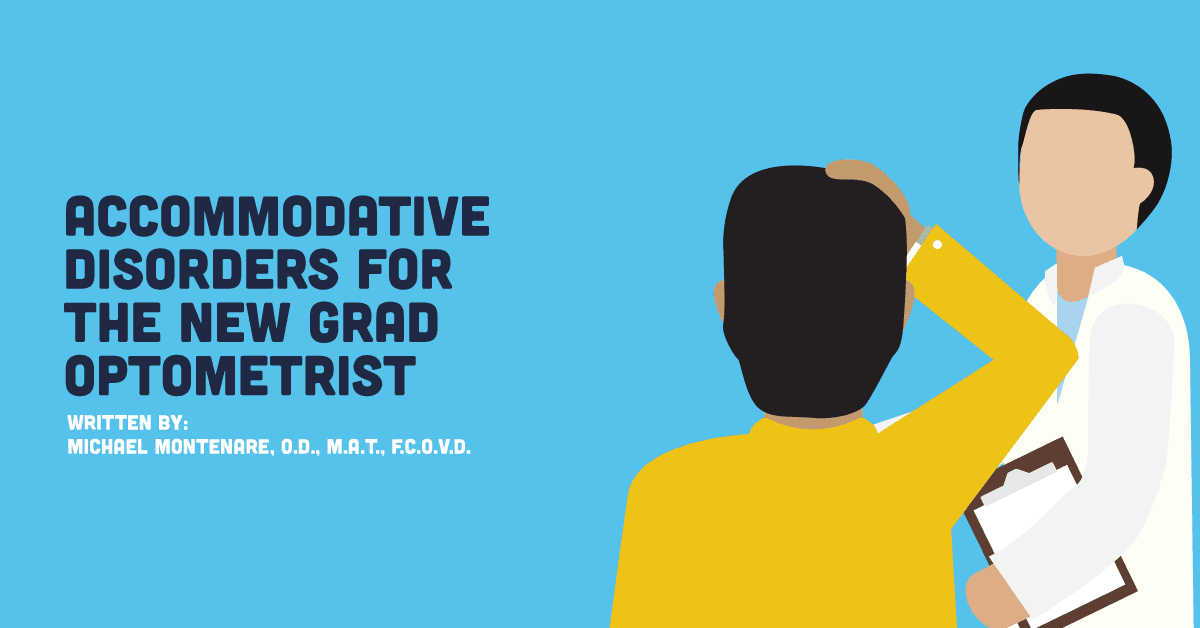This article has been contributed by Michael Montenare, O.D., M.A.T., F.C.O.V.D.
Accommodative dysfunction is one of the most common conditions encountered by optometrists, with an estimated prevalence of 6%. Thus, it is vital that optometrists be familiar with these conditions, so that we may provide the appropriate treatment. There are different types of accommodative dysfunction, and it's important to know how to test and diagnose for each one.
The Different Types of Accommodative Dysfunction
Confusion arises due to the various naming schemes of accommodative dysfunction. For instance, the American Optometric Association (AOA), in its clinical practice guidelines, identifies at least five types of accommodative dysfunction, whereas the ICD-10 recognizes only three for coding. Thus, the primary care optometrist should be familiar with both, for proper communication with insurance companies and with patients.
The three ways to code for accommodative dysfunction under ICD-10 are:
- Internal ophthalmoplegia (“complete” or “total”) H52.51-
- Paresis of accommodation H52.52-
- Spasm of accommodation H52.53-
The five types of accommodative dysfunction according to the AOA’s clinical practice guidelines are:
- Accommodative Insufficiency
- Ill-sustained accommodation
- Accommodative infacility
- Paralysis of accommodation
- Spasm of accommodation
As we will see, because accommodative insufficiency, ill-sustained accommodation, and accommodative infacility all involve difficulty with stimulating accommodation (but do not show a total paralysis), they best fall under the general category of “paresis of accommodation.” The final two disorders — paralysis of accommodation and spasm of accommodation — are more straightforward in their coding, which would be “internal ophthalmoplegia” and “spasm of accommodation,” respectively.
Accommodative Insufficiency
Accommodative insufficiency is defined as difficulty in stimulating accommodation. More technically, it is when the amplitude of accommodation (the maximum amount the patient can exert) falls below the expected age. This is separate from the normal reduction in accommodation due to presbyopia, and it is the most common type of accommodative disorder.
Symptoms of accommodative insufficiency include variable blurry vision at near, fatigue, eye strain, headaches, a pulling sensation around the eyes, movement of print when reading, double vision, avoidance of near work, and sensitivity to light. These symptoms are usually long-standing and associated with near tasks.
Ill-Sustained Accommodation
Ill-sustained accommodation is characterized as a normal amplitude of accommodation that deteriorates over time. If a patient has a normal amplitude at first, it may be reduced on repeated testing. Many authors consider this a subtype (or an “early stage”) of accommodative insufficiency. This is why the symptoms are generally the same, although they may be more pronounced at the end of the day.
Accommodative Infacility
Accommodative infacility is characterized as a slow change in accommodative response, both in stimulation and relaxation. Symptoms for this condition are the same as for accommodative insufficiency, with the addition of intermittent blur when looking from near to far or far to near.
For this condition, it is important to be aware that the amplitude of accommodation may be normal. This may be confusing. How can a patient exert a high level of accommodation but not be able to make a small step change? The reason is because this is a disorder of accommodative dynamics, which is why it is sometimes called “accommodative inertia.”
Paralysis of Accommodation
Paralysis of accommodation is defined as a total or complete loss of accommodation, either in one or both eyes. The accommodative system fails to respond to any stimulus. Although it is a rare condition, it is important to remember that it is often associated with organic causes, such as infection, trauma, poisoning, toxicity, or diabetes.
Some authors categorize paralysis of accommodation as a subtype of accommodative insufficiency. However, because of its association with organic disease, I like to treat it as a separate condition.
Spasm of Accommodation
Spasm of accommodation is characterized as difficulty in relaxing focus. More technically, the accommodative response is in excess of the accommodative stimulus. This condition may cause blurred vision at near (worse at the end of the day), blurred vision at far (pseudomyopia), headaches, eyestrain, and sensitivity to light.
The term “spasm of accommodation” is sometimes used interchangeably with “accommodative excess.” However, it is best to think of accommodative excess as a milder form of accommodative spasm. For instance, accommodative spasm is often associated with a triad of over-accommodation, over-convergence, and extreme miosis (“spasm of the near reflex”). This is a rare condition but can be caused by systemic or topical cholinergic drugs, myasthenia gravis, or even a brain tumor. In contrast, accommodative excess is a functional disorder, and is much more subtle in presentation.
Want more tips on binocular vision disorders? Check out our downloadable study guide!
References
- Scheiman M, Gallaway M, Coulter R, et al. Prevalence of vision and ocular disease conditions in a clinical pediatric population. J Am Optom Assoc 1996;67:193-202.
- Scheiman, M., & Wick, B. (2014). Clinical management of binocular vision: Heterophoric, accommodative, and eye movement disorders. Philadelphia: Wolters Kluwer/Lippincott Williams & Wilkins. p. 347-381
- Cooper, J. S., MS, OD., et al. Optometric Clinical Practice Guidelines: Care of the Patient with Accommodative and Vergence Dysfunction. Retrieved May 17, 2018, from https://www.aoa.org/optometrists/tools-and-resources/clinical-care-publications/clinical-practice-guidelines
